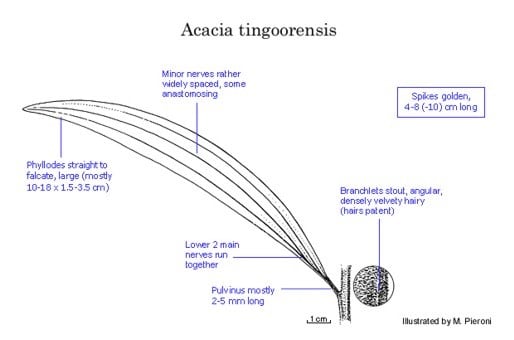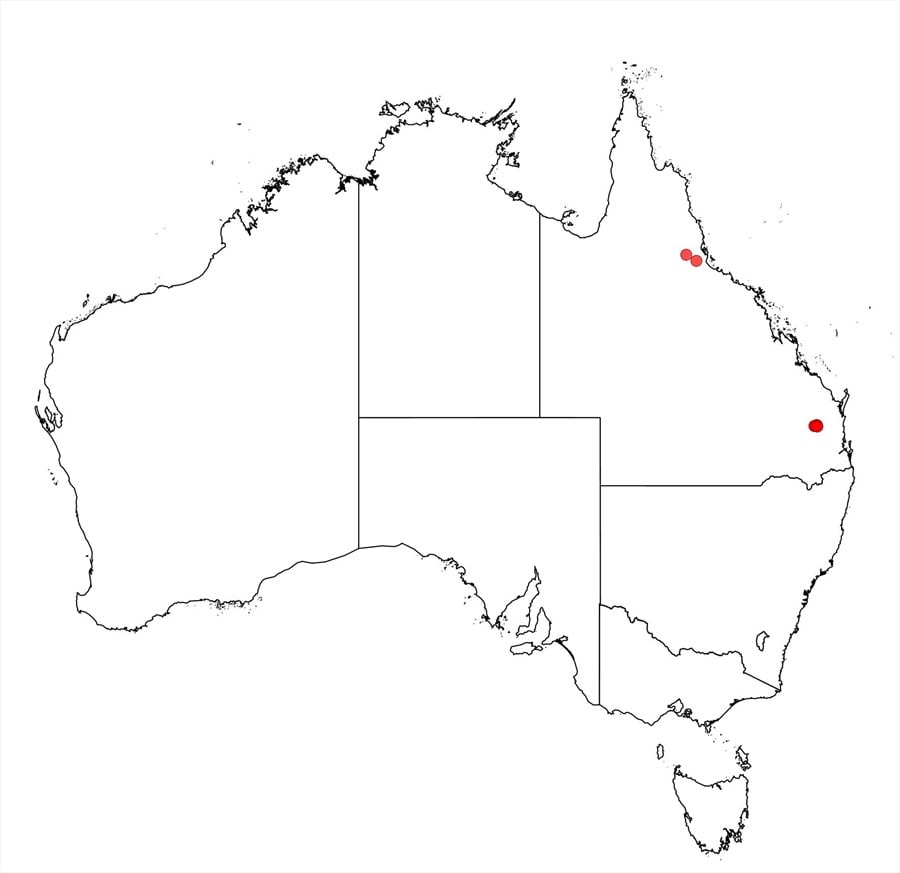Acacia tingoorensis Pedley
WATTLE
Acacias of Australia
Family
Fabaceae
Distribution
Restricted to near Kingaroy and Mt Garnet, Qld.
Description
Tree 3–8 m tall. Branchlets stout, acutely angled towards apices, velvety by dense, short, soft patent hairs. Phyllodes dimidiate to shallowly or obviously falcately recurved, 10–18 (–23) cm long, (10–) 15–35 mm wide, coriaceous, green, multistriate with 3 or 4 nerves more pronounced than the rest and free to the base or the lower 2 confluent near the pulvinus but free from lower margin, the minor nerves sub-distant (mostly 3–4 per mm), longitudinally anastomosing secondary nerves relatively few to sub-numerous, velvety or more commonly glabrous; pulvinus 2–5 (–8) mm long, commonly densely hairy and indistinct. Inflorescences simple or rudimentary racemes to 1 mm long, mostly 2 per axil; spike 4–8 (10) cm long, golden, the flowers sub-dense or somewhat widely spaced in the spikes; axis of spike glabrous or velvety hairy; peduncles (2–) 5–10, hairy. Flowers 5 merous. Calyx very shortly dissected, with indumentum sometimes only at the base; ovary densely pubescent. Pods sub-moniliform, to c. 6 cm long, 3–4 mm wide, straight to shallowly curved, rounded over seeds and moderately constricted between them, glabrous. Seeds longitudinal, oblong, 4 mm long, 2 mm wide, dark brown; aril terminal and yellow (at least when dry).
Phenology
Flowers Aug.–Sept.
Habitat
Grows on low hills; near Kingaroy it grows on shallow loam and sand as an understory in eucalypt woodland and forms dense stands in disturbed situations along roadverges; near Mt Garnet it grows on red lateritic soil.
Specimens
Qld: E of Durong, R.G.Coveny 2089 (A, AD, B, BRI, CANB, K, L, MEL, NSW, PERTH, U, UC, US); W of Tingoora on the Durong South road, R.G.Coveny 6757 & P.D.Hind (AD, BRI, CANB, K, LE, MEL, NSW, NU, RSA, US, Z); c. 60 mi [100 km] S of Mt Garnet, S.A.Morain 143 (BRI).
Notes
A member of the taxonomically complex ‘A cunninghamii group’ (see A. concurrens) which until recently was treated as a subspecies of A. longispicata from which it differs most obviously in having dense, erect (not appressed), velvety hairs on its branchlets.
FOA Reference
Data derived from Flora of Australia Volumes 11A (2001), 11B (2001) and 12 (1998), products of ABRS, ©Commonwealth of Australia
Author
Dr M.D.Tindale and Dr P.G.Kodela with the assistance of M.Bedward, S.J.Davies, C.Herscovitch, D.A.Keith and/or D.A.Morrison
B.R.Maslin
This identification key and fact sheets are available as a mobile application:
URL: https://apps.lucidcentral.org/wattle/
© Copyright 2018. All rights reserved.







